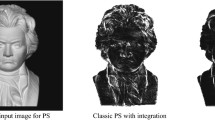Abstract
This paper presents the detailed performance analysis for a colour photometric stereo system proposed recently. The system recovers surface colour and surface normal for each surface patch separately, in the presence of highlights and shadows. The error analysis presented concerns every step of the algorithm, and it is based on the assumptions that errors may arise due to Gaussian image noise and errors in the accuracy with which the geometry of the illuminating set-up is known. The analysis is confirmed by experiments. The implications of this sensitivity analysis to the design of such a rig and the choice of threshold values for the algorithm are also discussed and recommendations to a designer are given.
Similar content being viewed by others
References
S. Barsky and M. Petrou, “The 4-source photometric stereo technique for 3-dimensional surfaces in the presence of highlights and shadows,” IEEE Trans. Patt. Anal. Machine Intell., Vol. 25, No. 10, pp. 1239–1252, 2003.
P.H. Christensen and L.G. Shapiro, “Three-dimensional shape from colour photometric stereo,” International Journal of Computer Vision, Vol. 13, No. 2, pp. 213–227, 1994.
E.N. Coleman and R. Jain, “Obtaining 3-dimensional shape of textured and specular surfaces using four-source photometry,” Computer Graphics and Image Processing, Vol. 18, pp. 309–328, 1982.
M.S. Drew, “Shape from color,” Technical Report CSS/LCCR TR 92-07, Simon Fraser School of Computer Science, 1992.
M.S. Drew, “Photometric stereo without multiple images,” Human Vision and Electronic Imaging, SPIE/IS&T, Vol. 3016, pp. 369–380, Feb. 1997.
G. Kay and T. Caelly, “Estimating the parameters of an illumination model using photometric stereo,” Graphical Models and Image Processing, Vol. 57, No. 5, pp. 365–388, 1995.
S.K. Nayar, K. Ikeuchi, and T. Kanade, “Determining shape and reflectance of hybrid surfaces by photometric sampling,” IEEE Trans. on Robotics and Automation, Vol. 6, No. 4, pp. 418–431, 1990.
A.P. Petrov and G.N. Antonova, “Resolving the color-image irradiance equation,” Color Research and Application, Vol. 21, pp. 97–103, 1996.
B.T. Phong, “Illumination for computer generated pictures,” Communications of the ACM, Vol. 18, No. 6, 1975.
H.D. Tagare and R.J.P. de Figueiredo, “A theory of photometric stereo for a class of diffuse no-lambertian surfaces,” IEEE Trans. Patt. Anal. Machine Intell., Vol. 13, No. 2, pp. 133–152, 1991.
R.J. Woodham, “Photometric method for determining surface orientation from multiple images,” Opt. Eng., Vol. 19, No. 1, pp. 139–144, 1980.
Author information
Authors and Affiliations
Rights and permissions
About this article
Cite this article
Barsky, S., Petrou, M. Design Issues for a Colour Photometric Stereo System. J Math Imaging Vis 24, 143–162 (2006). https://doi.org/10.1007/s10851-005-3618-y
Published:
Issue Date:
DOI: https://doi.org/10.1007/s10851-005-3618-y




